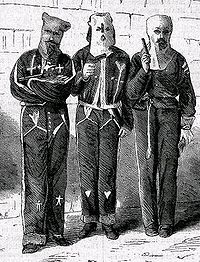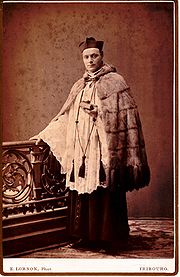
Hood (headgear)
Encyclopedia



Headgear
Headgear, headwear or headdress is the name given to any element of clothing which is worn on one's head.Headgear serve a variety of purposes:...
that covers most of the head
Human head
In human anatomy, the head is the upper portion of the human body. It supports the face and is maintained by the skull, which itself encloses the brain.-Cultural importance:...
and neck
Neck
The neck is the part of the body, on many terrestrial or secondarily aquatic vertebrates, that distinguishes the head from the torso or trunk. The adjective signifying "of the neck" is cervical .-Boner anatomy: The cervical spine:The cervical portion of the human spine comprises seven boney...
and sometimes the face
Face
The face is a central sense organ complex, for those animals that have one, normally on the ventral surface of the head, and can, depending on the definition in the human case, include the hair, forehead, eyebrow, eyelashes, eyes, nose, ears, cheeks, mouth, lips, philtrum, temple, teeth, skin, and...
. They may be worn for protection from the environment, for fashion, as a form of traditional dress
Clothing
Clothing refers to any covering for the human body that is worn. The wearing of clothing is exclusively a human characteristic and is a feature of nearly all human societies...
or uniform
Uniform
A uniform is a set of standard clothing worn by members of an organization while participating in that organization's activity. Modern uniforms are worn by armed forces and paramilitary organizations such as police, emergency services, security guards, in some workplaces and schools and by inmates...
, to prevent the wearer from seeing or to prevent the wearer from being identified.
History and description
Historically, hoods were either similar to modern hoods, often forming part of a cloakCloak
A cloak is a type of loose garment that is worn over indoor clothing and serves the same purpose as an overcoat; it protects the wearer from the cold, rain or wind for example, or it may form part of a fashionable outfit or uniform. Cloaks are as old as human history; there has nearly always been...
or cape
Cape
Cape can be used to describe any sleeveless outer garment, such as a poncho, but usually it is a long garment that covers only the back half of the wearer, fastening around the neck. They were common in medieval Europe, especially when combined with a hood in the chaperon, and have had periodic...
, or a separate form of headgear. Hoods with short capes, called chaperons
Chaperon (headgear)
Chaperon was a form of hood or, later, highly versatile hat worn in all parts of Western Europe in the Middle Ages. Initially a utilitarian garment, it first grew a long partly decorative tail behind, and then developed into a complex, versatile and expensive headgear after what was originally the...
in French, were extremely common in medieval Europe, and later evolved into extravagant hats. Soft hoods were worn by men under hats. Hoods have also been used as part of uniforms for organizations such as the Ku Klux Klan
Ku Klux Klan
Ku Klux Klan, often abbreviated KKK and informally known as the Klan, is the name of three distinct past and present far-right organizations in the United States, which have advocated extremist reactionary currents such as white supremacy, white nationalism, and anti-immigration, historically...
.
A hood to hide or control the wearer often covers the whole head, with the result that the wearer can see little or nothing, like a blindfold
Blindfold
A blindfold is a garment, usually of cloth, tied to one's head to cover the eyes to disable the wearer's sight. It can be worn when the eyes are in a closed state and thus prevents the wearer from opening them...
, or it can be to prevent identification of the wearer. It may be used on or by a person who has been arrested or kidnapped, or about to suffer judicial execution; this practice is known as hooding
Hooding
Hooding is the placing of a hood over the entire head of a prisoner. One legal scholar considers the hooding of prisoners to be a violation of international law, specifically the Third and Fourth Geneva Conventions, which demand that persons in the power of occupying forces be treated humanely....
. The hood may be simply a bag
Bag
- Types of flexible containers :* Antistatic bag, used for shipping electronic components* Bag-In-Box* Bin bag, garbage bag, or trash bag* Book bag* Bulk bag, a name for a flexible intermediate bulk container* Burn bag* Diplomatic bag* Duffel bag...
; it may be intended to be, and/or experienced as, humiliating (see hood event
Hood event
The Hood event was an incident on July 4, 2003 following the 2003 invasion of Iraq where a group of Turkish military personnel operating in northern Iraq were captured, led away with hoods over their heads, and interrogated by the United States military...
).
Traditional women's hoods varied from close-fitting, soft headgear (e.g. snood
Snood (headgear)
A snood is historically a type of European female headgear, or in modern times a tubular neck scarf. In the most common form the headgear resembles a close-fitting hood worn over the back of the head...
) to stiffened, structured hoods (e.g. gable hood
Gable hood
A gable hood, English hood or gable headdress is an English woman's headdress of c. 1500–1550, so-called because its pointed shape resembles the gable of a house...
) or very large coverings made of material over a frame which fashionable women wore over towering wigs or hairstyles to protect them from the elements (e.g. calash).
Today, fashion hoods are generally soft headcoverings which form part of a larger garment (e.g. an overcoat
Overcoat
An overcoat is a type of long coat intended to be worn as the outermost garment. Overcoats usually extend below the knee, but are sometimes mistakenly referred to as topcoats, which are short coats that end at or above the knees. Topcoats and overcoats together are known as outercoats...
, shirt
Shirt
A shirt is a cloth garment for the upper body. Originally an undergarment worn exclusively by men, it has become, in American English, a catch-all term for almost any garment other than outerwear such as sweaters, coats, jackets, or undergarments such as bras, vests or base layers...
or cloak
Cloak
A cloak is a type of loose garment that is worn over indoor clothing and serves the same purpose as an overcoat; it protects the wearer from the cold, rain or wind for example, or it may form part of a fashionable outfit or uniform. Cloaks are as old as human history; there has nearly always been...
; an exception is a rain hood which is not part of a larger garment). They can be pulled up over the head when needed, or left to hang down the back when not. They may also be detachable to turn a winter overcoat into a summer one, or may be designed to be folded or rolled into a small pocket in the neck of the garment when not in use.
Types of hoods
The InuitInuit
The Inuit are a group of culturally similar indigenous peoples inhabiting the Arctic regions of Canada , Denmark , Russia and the United States . Inuit means “the people” in the Inuktitut language...
peoples of the Arctic
Arctic
The Arctic is a region located at the northern-most part of the Earth. The Arctic consists of the Arctic Ocean and parts of Canada, Russia, Greenland, the United States, Norway, Sweden, Finland, and Iceland. The Arctic region consists of a vast, ice-covered ocean, surrounded by treeless permafrost...
were expert clothing manufacturers, and the women's anorak
Anorak
An anorak or parka is a type of heavy jacket with a hood, often lined with fur or fake fur, so as to protect the face from a combination of freezing temperatures and wind...
, technically called an amauti
Amauti
The amauti is the traditional eastern Arctic Inuit parka designed to carry a child in the same garment as the parent so that the child is warm and safe from frostbite, wind and cold. The amauti can be made from a variety of materials including sealskin, caribou skin or duffle with a windproof...
, features a large hood used to shelter an infant on its mother's back.
In Japan
Japan
Japan is an island nation in East Asia. Located in the Pacific Ocean, it lies to the east of the Sea of Japan, China, North Korea, South Korea and Russia, stretching from the Sea of Okhotsk in the north to the East China Sea and Taiwan in the south...
hoods covered with chainmail or armour plates (tatami zukin) were worn by samurai
Samurai
is the term for the military nobility of pre-industrial Japan. According to translator William Scott Wilson: "In Chinese, the character 侍 was originally a verb meaning to wait upon or accompany a person in the upper ranks of society, and this is also true of the original term in Japanese, saburau...
warriors and their retainers.
Scuba divers
Scuba diving
Scuba diving is a form of underwater diving in which a diver uses a scuba set to breathe underwater....
who dive in cold water often wear neoprene
Neoprene
Neoprene or polychloroprene is a family of synthetic rubbers that are produced by polymerization of chloroprene. Neoprene in general has good chemical stability, and maintains flexibility over a wide temperature range...
hoods for thermal insulation
Thermal insulation
Thermal insulation is the reduction of the effects of the various processes of heat transfer between objects in thermal contact or in range of radiative influence. Heat transfer is the transfer of thermal energy between objects of differing temperature...
. They cover the whole head and neck except the face.
A hood is a component of academic dress that is an often bright and decorative garment worn over a gown and used only at graduations or on other special occasions. The shape of hoods of universities and colleges in the UK and in many Commonwealth countries have been derived from those prescribed at the Universities of Oxford and Cambridge. Oxford bachelors and masters use a 'simple' (or 'Burgon' shape) consisting of hood with a cowl (headcovering) but without a cape, whereas the University of Cambridge uses a 'full' shape, with both cowl and square cape and substantial liripipe for all hoods. Other English universities use one of these patterns or adapt them; for example, the University of London uses the full Cambridge shape but with rounded corners to the cape. Newer universities, such as the University of Kent at Canterbury use a hood with triangular cape but with no cowl, and with a distinctive V shaped segment denoting the faculty. The hoods of the University of Aberdeen have a rounded flat cape but no cowl. The pattern of hoods in the US largely follow an intercollegiate code. The length of the hood and the width of its velvet trim indicate the academic achievement level of the wearer; the color of the trim indicates the discipline/field in which the degree is held; and the lining of hoods in academic dress represents the particular institution from which the degree was earned.
Close-fitting hoods are also used in BDSM
BDSM
BDSM is an erotic preference and a form of sexual expression involving the consensual use of restraint, intense sensory stimulation, and fantasy power role-play. The compound acronym BDSM is derived from the terms bondage and discipline , dominance and submission , and sadism and masochism...
(see bondage hood).
See also
- Balaclava (clothing)
- BurqiniBurqiniA burqini swimsuit is a type of swimsuit for women designed by Lebanese Australian Aheda Zanetti under the company name Ahiida....
- French HoodFrench hoodA French hood is a type of woman's headgear popular in Western Europe in the sixteenth century.The French hood is characterized by a rounded shape, contrasted with the angular "English" or gable hood. It is worn over a coif, and has a black veil attached to the back. It was introduced to England...
- Gable hoodGable hoodA gable hood, English hood or gable headdress is an English woman's headdress of c. 1500–1550, so-called because its pointed shape resembles the gable of a house...
- HeadscarfHeadscarfHeadscarves or head scarves are scarves covering most or all of the top of a woman's hair and her head. Headscarves may be worn for a variety of purposes, such as for warmth, for sanitation, for fashion or social distinction; with religious significance, to hide baldness, out of modesty, or other...
- HoodieHoodieA hoodie is a sweatshirt with a hood. The characteristic design includes large frontal pockets, a hood, and a drawstring to adjust the hood opening. They are sometimes worn with sweatpants. Some hoodies have zippers on them to allow easy removal much like a jacket...
- Sartorial hijabSartorial hijabThis list of types of sartorial hijab indexes styles of clothing found in predominantly Muslim societies commonly associated with the word hijab...

